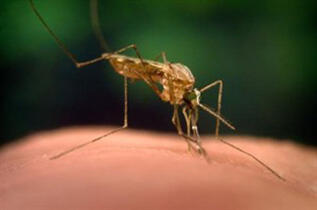
Researchers from LSTM have found that a single genetic mutation causes resistance to DDT and pyrethroids (an insecticide class used in mosquito nets). With the continuing rise of resistance the research, published in the journal Genome Biology, is key as scientists say that this knowledge could help improve malaria control strategies.
The researchers, led by Dr Charles Wondji, used a wide range of methods to narrow down how the resistance works, finding a single mutation in the GSTe2 gene, which makes insects break down DDT so it’s no longer toxic. They have also shown that this gene makes insects resistant to pyrethroids raising the concern that GSTe2 gene could protect mosquitoes against the major insecticides used in public health.
Mosquitoes (Anopheles funestus) are vectors of malaria, and most strategies for combating the spread of the disease focus on control of mosquito populations using insecticides. The spread of resistance genes could hold back efforts to prevent the disease. The authors say that knowing how resistance works will help to develop tests, and stop these genes from spreading amongst mosquito populations.
Charles Wondji said: ‘We found a population of mosquitoes fully resistant to DDT (no mortality when they were treated with DDT) but also to pyrethroids. So we wanted to elucidate the molecular basis of that resistance in the population and design a field applicable diagnostic assay for its monitoring.’
They took mosquitoes from Pahou in Benin, which were resistant to DDT and pyrethroids, and mosquitoes from a laboratory fully susceptible strain and did a genome wide comparison study. They identified the GSTe2 gene as being upregulated - producing a lot of protein - in Benin mosquitoes.
They found that a single mutation (L119F) changed a non-resistant version of the GSTe2 gene to a DDT resistant version. They designed a DNA-based diagnostic test for this type of resistance (metabolic resistance) and confirmed that this mutation was found in mosquitoes from other areas of the world with DDT resistance but was completely absent in regions without. X-ray crystallography of the protein coded by the gene illustrated exactly how the mutation conferred resistance, by opening up the ‘active site’ where DDT molecules bind to the protein, so more can be broken down. This means that the mosquito can survive by breaking down the poison into non-toxic substances.
They also introduced the gene into fruit flies (Drosophila melanogaster) and found they became resistant to DDT and pyrethroids compared to controls, confirming that just this single mutation is enough to make mosquitoes resistant to both DDT and permethrin.
Wondji says: ‘For the first time, we have been able to identify a molecular marker for metabolic resistance (the type of resistance most likely to lead to control failure) in a mosquito population and to design a DNA-based diagnostic assay. Such tools will allow control programs to detect and track resistance at an early stage in the field, which is an essential requirement to successfully tackle the growing problem of insecticide resistance in vector control. This significant progress opens the door for us to do this with other forms of resistance as well and in other vector species.’